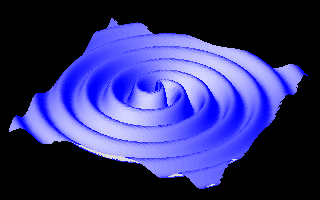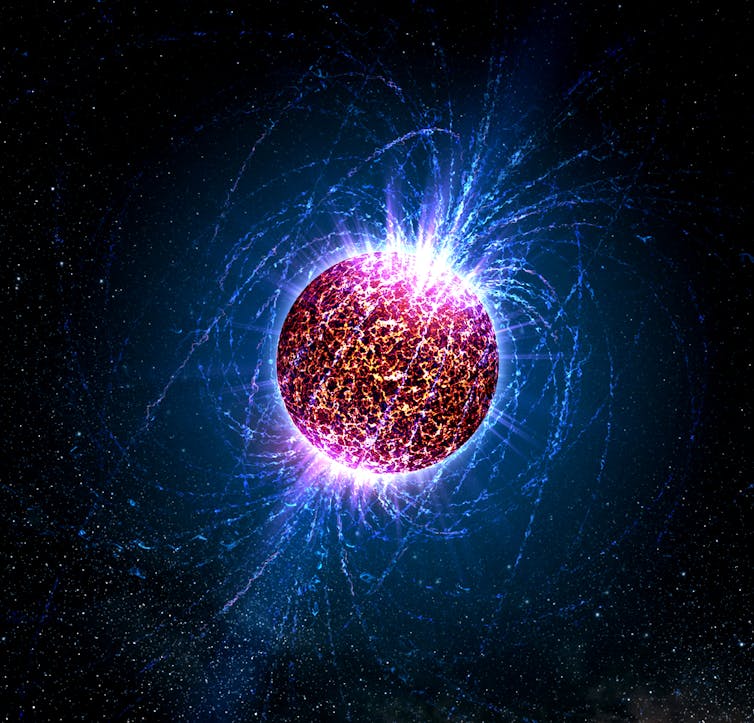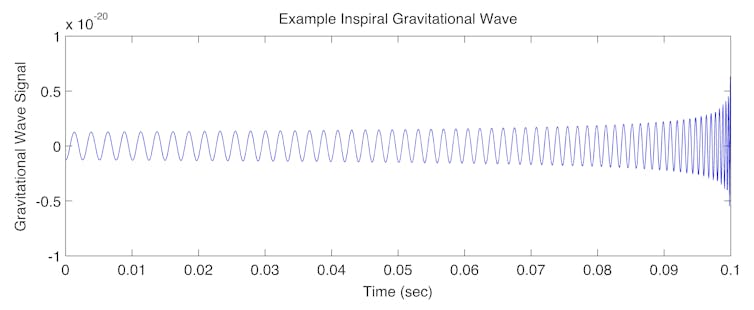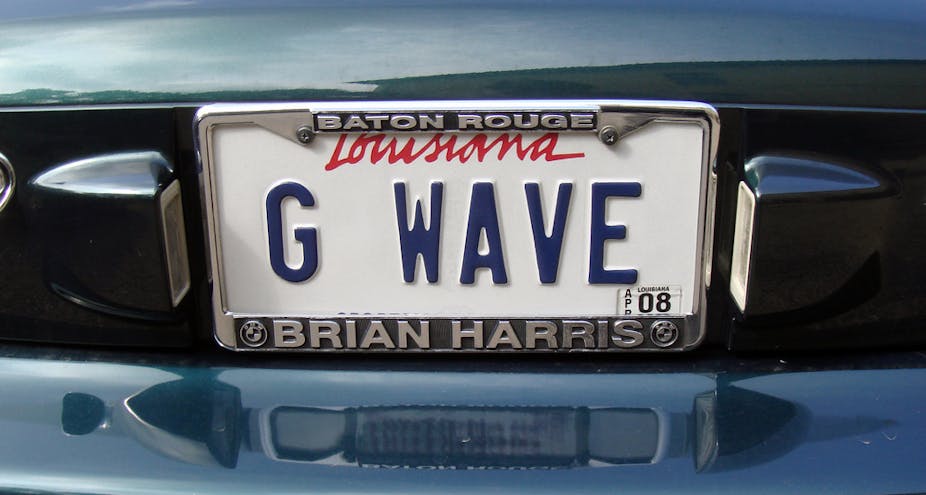In my previous article we discussed the “who, what, when, where and how” of the worldwide gravitational wave detection effort. The observant observer will have noticed we’re still missing the “why”.
Why bother spending hundreds of millions of dollars to detect extraordinarily tiny ripples in space that have come from the furthest corners of the universe? Why bother directly detecting these waves when we’ve already inferred their existence? Why bother verifying Einstein’s theory of gravity when we know it’s right?
These are all reasonable questions. But not only do they have reasonable answers, they have answers that will undeniably have far-reaching implications for the way we perceive the universe.
Not because they are easy …
Of course a first answer to the “why bother” questions is: “because it’s there”.
Attempting to understand the basic workings of the universe is a pure endeavour, and gravitational wave science is just one part of this. Moreover, the actual detection of gravitational waves presents one of the greatest technical challenges ever attempted. In and of itself this can provide significant impetus.
Then there are the pragmatic among us who want spin-off technologies. Science for science’s sake undoubtedly spawns technology, and gravitational wave science will be no different. The detection effort is already enhancing various fields of research including optics, lasers, digital signal processing and data visualisation.
Gravitational waves themselves may even be the technological spin-off – some have proposed using them for new communication methods with “very low probability of intercept”.
The idea that sufficiently advanced civilisations may already be using this technology has not been lost on NASA.
But there is also pure science to be done – and for me, that is the truly exciting part.

Gravitational waves are the apparatus
Let’s jump forward five years to imagine a scenario. One Direction have lost their way and Australia’s Got Talent still hasn’t found any of the aforementioned talent. But the LIGO Scientific Collaboration has successfully detected a gravitational wave signal and the American physicist Kip Thorne is preparing his Nobel Prize acceptance speech. Gravitational waves are being detected on a weekly, even daily basis.
It’s now time to do some real science. It’s time to probe the physics of the universe using gravitational waves as the apparatus.
As a first port of call, we can test the accuracy with which Einstein’s theory of general relativity actually describes gravity.
Contrary to popular belief, there are numerous alternative theories of gravity in the mainstream scientific literature (there are also many crackpot theories that are not in the mainstream literature).
Many of these aim to recast the issue of dark matter and dark energy as a problem with our understanding of gravity itself.
But as with any good scientific theory, Einstein’s version of gravity makes unique predictions. And these can be rigorously tested using gravitational waves.
Testing Einstein
Take, for example, the orientation of the gravitational waves oscillations, known as their polarisation. General relativity postulates that only two polarisations of gravitational waves exist – so-called “plus” and “cross” polarisations.
Interestingly, almost all reputable alternatives to Einstein’s gravity postulate the existence of gravitational waves – but almost all of those say there should be somewhere between three and six polarisations.
These include the plus and cross polarisations that relativity proposes. But if you find any of the other polarisations, you’ve proven Einstein wrong!
Another particularly beautiful example relates to black holes. According to Einstein’s theory, black holes are incredibly simple beasts. In fact, an astrophysical black hole is completely characterised by only its mass and its rotation rate. This is known as the no-hair conjecture.
Gravitational waves provide an extremely robust way of testing the “hairiness” of a black hole. Just like hitting the surface of a drum, a black hole will ring with characteristic oscillations. Each frequency of oscillation, and also the rate at which that oscillation is damped, depends only on the mass and rotation rate of the black hole.
So when you measure a single frequency and its damping time you determine everything about the black hole. Measure a second frequency from the same black hole and – if general relativity is right – you will learn exactly the same thing as with your first measurement. If these two measurements are inconsistent with one another, general relativity is wrong!

Nuclear physics
Gravitational waves will do much more than just test Einstein’s theory of gravity. They will also allow us to understand matter in conditions inaccessible on Earth.
When we observe neutron stars today we are doing so using electromagnetic radiation – light, radio waves, X-rays, etc. Each of these types of waves are emitted from different heights above the surface of the neutron star: some from very close to the surface of the star and some from much further out in the atmosphere.
But the really interesting physics is in their centre. Here, the densities are more than 100,000,000,000,000 times that of water! Magnetic fields inside neutron stars are up to 100,000,000,000 larger than the strongest fields ever produced on Earth.
Gravitational waves are neither scattered nor absorbed. A gravitational wave therefore offers a view into the heart of a neutron star, a region forever hidden to us by conventional means. Probing the interior of neutron stars will give us new insight into the way matter behaves in some of the most extreme environments found in the universe.
The universe as a whole
The gravitational wave detection effort is, first and foremost, experimental physics. But the second stage of gravitational wave science will introduce the new field of gravitational wave astronomy.
All sources of gravitational waves that we hope to observe will come from the cosmos.
One of the exciting burst sources for the LIGO collaboration are from core-collapse supernovae – those spectacular explosions that occur at the end of a star’s life.
As with observations of neutron stars, core-collapse supernovae are optically thick, implying light observed does not come from anywhere near the core of the explosion. Gravitational waves will directly probe the core of these collapsing objects.
A truly exciting prospect is that of multi-messenger astronomy – the simultaneous observation of a light signal and gravitational wave from the same event. There are existing programs within the LIGO collaboration that will analyse gravitational wave burst signals in real-time and trigger optical telescopes to look at the corresponding patch of sky.
Projects such as these will enable us to catch supernovae and gamma-ray bursts in the act, not only providing stringent confirmation of the gravitational wave signal, but also allowing us to study such events in all their gory detail.
Coalescing compact objects such as black holes, neutron stars and white dwarfs are excellent sources of gravitational waves.
Observing black holes
It has already been mentioned that observations of black holes will allow us to rigorously test Einstein’s gravity, but they will be able to do so much more.
One of the most promising sources for LIGO are coalescing black holes.
Imagine two black holes in mutual orbit. As they emit gravitational waves, the system loses energy and the orbit becomes tighter. This process continues until the black holes eventually merge. An entire waveform, as predicted from computer simulations, is shown below.


It turns out that specific properties of these waveforms encode information about the two black holes, and also information about their distance.
Nobel Laureate Brian Schmidt and his team used observations of supernovae as standard candles to probe the expansion of the universe, work which led to them winning the 2011 Nobel Prize. Similarly, binary black hole coalescences are known as gravitational wave standard sirens (distinct from the all-female cappella group).
These standard sirens provide an extremely important independent measure of the expansion of the universe. Unlike the standard candles, it turns out that the sirens are completely independent of the cosmic distance ladder and can therefore be used to test its robustness.
The more exotic
In my failed attempt at brevity I have skipped many aspects in which gravitational wave science will further our understanding of the universe.
For example, consistent observations of black holes and neutron stars will aid our understanding of their distribution throughout the galaxy and the local universe. In turn, this will develop our knowledge of the way these objects, as well as galaxies and clusters form and evolve.
And then there’s the more exotic – such as attempts to directly probe the vibrations of cosmic strings, the number of dimensions of the universe, or the imprints left from cosmic inflation.
But perhaps the most exciting prospect of all is that we will discover aspects of the universe that no-one had anticipated.
The focus on gravitational wave science is extremely broad. When gravitational waves are successfully detected in the coming years, it’s fair to say that the fun will only just be beginning.
This is the second of two articles on gravitational waves by Paul Lasky. It follows on from Rippling space-time: how to catch Einstein’s gravitational waves.
You can help the search to understand the universe by donating valuable computer time to the Einstein@Home project.

